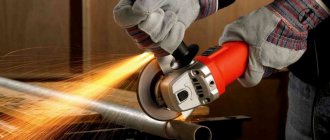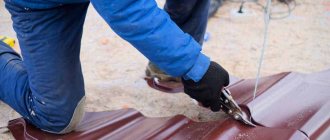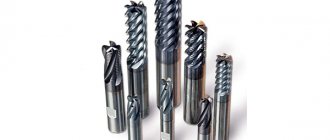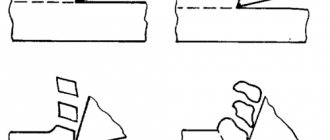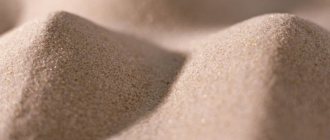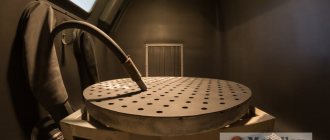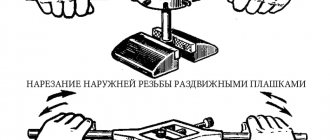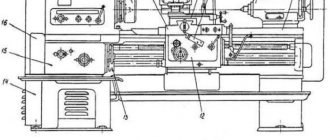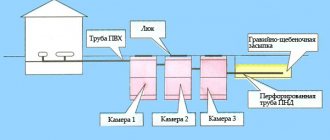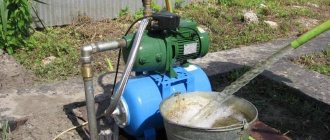Design and operating principle
Carbide disk cutter for metal - equipment for working on milling and turning machines. Varieties:
- Cut-off. Outer diameter - from 20 to 315 mm. The teeth are cut from the main part of the nozzle. The hole can be regular or with a keyway. There is no hub. Has no differences in thickness. When working with cutting cutters, coolant must be supplied to the cutting area so that they do not overheat.
- Slotted. Designed for processing grooves and keyways with high precision. This is possible thanks to the special shape of the teeth, sharpened on three sides. The cutting edge located on the sides forms a right angle. The hub protrudes above the body of the nozzle to a height of 0.2–0.6 mm.
Disc cutters consist of three parts:
- main disk (body);
- teeth;
- hub, inside of which there is a mounting hole.
The cutter can be solid, welded or prefabricated. Welded ones can be made of two types of metals, solid ones - from one. Prefabricated ones can consist of three parts - the shank, the body of the equipment, and the working part.
The operating principle can be described by several stages of processing parts:
- The nozzle is fixed in the machine chuck.
- The workpiece is placed in a vice.
- Preliminary configuration of the equipment is carried out. The accuracy of alignment of the workpiece relative to the cutter itself is checked.
- The equipment turns on. Once launched, the sharp teeth of the nozzle cut a hole in the metal.
The master controls the work process until the machine is turned off. It sets the depth, dimensions of future holes, and duration of processing.
Disc cutters for metal are designed to perform:
- milling of spline and keyways;
- cutting recesses of different sizes;
- selection of grooves of different depths;
- trimming profits, casting allowances;
- cutting rolled products into separate pieces of the required size.
According to GOST, the equipment is intended for processing steel and cast iron workpieces, but in practice it is used when working with different metals.
Disc cutter (Photo: Instagram / makitaland)
type of instalation
End
End cutting elements are usually used in vertical and horizontal milling machines, as well as in hand-held machines. Their main design feature is the presence of a shank to which a disk cutting element is attached.
There are two types of end mills:
- Without retaining ring.
- With a retaining ring, which is used as a bearing. The retaining ring may be located above or below the cutting element.
In addition, according to the type of construction they are:
- Solid - the shank is soldered into the disk;
- Collapsible - the cutting element is attached to the shank using a bolt.
Note! The safety instructions allow replacement of nozzles only when the equipment is de-energized.
This type of tool is designed for processing planes, grooves and ledges.
Shell disc cutter
Mounted
Nozzles of this type are a body that has a mounting hole and teeth. They are used for profile and flat processing of wooden workpieces. Their main purpose is to saw and process grooves.
It should be noted that for cutting splines and narrow grooves on parts, as well as for cutting materials, thin mounted disks, which are also called saws, are used. The peculiarity of such attachments is that they alternately sharpen chamfers on one side and the other at a certain angle.
The chamfer can cut off 1/3 - 1/5 of the length of the cutting edge. Therefore, each tooth of the nozzle cuts chips with a width less than the width of the groove itself. This improves chip removal and prevents tip jamming and breakage.
Grooving cutter
Characteristics and material
The characteristics and material from which the nozzle can be made are indicated in the state document GOST 2679-93. Characteristics of disc cutters for metal, prescribed in GOST:
- Diameter range - from 20 to 315 mm.
- Number of teeth - from 32 to 200.
- Width - from 0.2 to 3.5 mm.
- The maximum width deviation is up to 0.3 mm.
In the manufacture of cutters for metal, high-speed steel is most often used, but alloy and carbon steel can also be used.
The cutting parts are made of hard alloys with high wear resistance. Additionally, they can be coated with mineral ceramics, metal ceramics, or diamond coating. The shank must be made of ductile metal with high resistance to torsion and impact. The best steel options are St 40X, St 45, U10, U8.
Slotting (slotted) and cutting cutters
Slotting cutters (slotted) are used for cutting narrow slots and slots in nuts, screw heads and screws.
Disc cutters are a tool designed for cutting straight splines, grooves and cutting work in products made of steel and ferrous metals. There are three types of cutting cutters:
- with fine teeth (type-1),
- with medium tooth (type-2)
- with a large tooth (type-3).
Mills with fine and medium teeth are used for cutting thin workpieces, thin-walled pipes, for cutting shallow slots in screw heads, and with large teeth - for cutting deep and narrow grooves and for cutting work. For processing steel and cast iron, cutters with a larger number of teeth are used than for processing aluminum and light alloys. As a rule, cutting cutters are made of high-speed steel R6M5 and R18. Technical conditions for slotting and cutting cutters are determined by GOST 2679-93.
Similar articles:
- Hob cutters for cutting spur and helical cylindrical wheels, depending on their purpose, are divided into finishing cutters and roughing cutters. The latter are of two types: roughing cutters for cutting gears for shaving. Hobs for cylindrical wheels are manufactured to...
">Hobs
- In some cases, preliminary cutting of the teeth of coarse-grained wheels is carried out with sets of disc gear-cutting cutters. Fig.1. A set of roughing disc gear-cutting (modular) cutters. Fig.2. Rough disk gear-cutting (modular) cutter with insert teeth. In Fig.1. schematically shows the room...
“>Rough disc gear cutters.
- Disc gear-cutting (modular) cutters are used for preliminary and final cutting of cylindrical spur and helical gears and chevron wheels with a groove between the gear rims on the rim for tool exit. These cutters are also used for preliminary, and in some cases, finishing...
">Disc gear-cutting (modular) cutters
- Finger cutters (Fig. 1.), designed for cutting spur gears, work using the copying method, and the profile of such a cutter is the same as the profile of the cavity between the teeth of the wheel being cut. Fig.1. Finger gear cutter. Finger cutters designed for cutting chevron…
">Finger hobbing (modular) cutters
- A set of cutters is a group of cutters that are selected according to the profile and dimensions of the workpiece and are mounted on one common mandrel. The set includes: cutters of the required shapes and sizes, a mandrel and rings, through which the required distances between cutters are set. Set of cutters pos...
">Set of cutters
News archive:
- Mills for grooves of segment keys are manufactured in accordance with GOST 6648-59. The cutters are fastened to the machine spindle using a cylindrical shank. The dimensions of these cutters are shown in Fig. 1. and Fig.2. Fig.1. Shank cutters for segment keys. Fig.2. Mounted cutters for grooves of segment keys…
">Cutters for slot keys
- Mills for machine T-slots are made in two types: type I - with a conical shank without a foot; type II - with a conical shank with a claw. The dimensions of cutters for T-slots are shown in Fig. 1. Fig.1. Mills for machine T-slots.
">Milling cutters for machine T-slots
- Shaped cutters are produced with a semicircular convex profile and a semicircular concave profile. Other shaped cutters are not standardized and are manufactured according to departmental and factory standards. The technical conditions for the manufacture and acceptance of semicircular cutters are standardized according to GOST 4051-48. Once…
">Semicircular cutters, concave and convex
- Mills for milling grooves between the teeth of shaped backed cutters are single-angle and double-angle. The former are used for milling straight grooves, and the latter are used for helical flute milling cutters. the dimensions of these cutters are shown in Fig. 1. and Fig.2. Fig.1. Angle cutters for backed grooves…
">Grooving cutters
- Asymmetrical double-angle cutters are used for milling straight and helical grooves in cutters and other cutting tools. The dimensions of double-angle cutters are shown in Fig. 1. Fig.1. Double angle asymmetrical cutters.
">Angle cutters (double-angle)
Next page >>
Daoist Yoga
Kinds
Accessories for power tools and industrial equipment are divided into several types. The main ones are double-sided, three-sided, and groove cutters.
Double sided
Double-sided disc cutters are used for processing different shoulders. The cutting edges are located on the cylindrical part, one of the ends.
Double-sided disc cutter (Photo: Instagram / grindingcenter)
Tripartite
Equipment with figured sharpening. They have cutting edges that are located on three sides. Needed to create splines or grooves.
Grooved
Equipment with reverse sampling form. It can be solid or with a removable shank. Used for cutting grooves of different depths.
Selection principles
Even a specialist can get confused in the variety of equipment. Therefore, when purchasing attachments, you need to consider what criteria the disc cutters must meet.
Criteria
Criteria for choosing a disk cutter for metal:
- number of teeth;
- material.
It is necessary to carefully inspect the equipment for visual damage, irregularities, and chips on the cutting parts.
Number of teeth
The cleanliness and accuracy of the cuts and processing speed depend on the number of teeth. As their number increases, the load on the electric motor increases, and the process of removing metal shavings from the working area slows down.
Number of teeth:
- small - up to 40;
- average - up to 80;
- large - more than 90.
For home work, you need to choose discs with a medium number of teeth. They are productive, do not put much strain on the electric motor, and metal shavings are removed from the working area fairly quickly.
If you need a clean cut with high precision, it is better to choose a cutter with many teeth. For primary processing, equipment with large teeth is suitable.
Different types of cutters (Photo: Instagram / grindingcenter)
Material
Types of materials:
- To cut metals with a strength of up to 800 MPa, you need to use equipment made of high-speed steel, to which up to 5% molybdenum is added.
- To process metals with a strength of over 800 MPa, it is recommended to use cutters made of tool steel, to which up to 5% cobalt is added.
- To work with stainless steel, special disk tools are suitable, on the cutting parts of which soldering tips made of tungsten carbide are attached.
To process precious materials, it is necessary to use high-precision equipment, which is made from high-speed steel of the highest quality.
Advantages
Positive sides:
- High-quality processing of workpieces.
- Obtaining high precision and clean cuts when using discs with many teeth.
- Performing various technological operations.
- Versatility of use. You can use the equipment on machines of different manufacturers.
Manufacturers and prices
Manufacturers:
- Metabo;
- Corvette;
- Jet;
- "Tool-service";
- stayer;
- "Globe".
The average price is 1000 rubles.
Cutting with a disk cutter (Photo: Instagram / jet_tools_rus)
Nuances of equipment selection
Choosing the right tool for yourself is not difficult; you just need to know the characteristics and parameters of the equipment. Such parameters include the number of teeth and the material from which the product is made. The key to choosing a product material is the strength of the metal you are going to cut.
Required number of teeth
The processing speed and cleanliness of the cut depend on the number of teeth the tool has .
The greater their number, the cleaner the cutting area will be. But at the same time, the load on the electric motor greatly increases, and the process of removing chips from the cutting site worsens. And because of these reasons, the speed of penetration into the thickness of the metal and rotation of the tool decreases. If the number of teeth is small, then the size of the sinuses between them increases. These factors speed up cutting and facilitate removal of chips. But there will be grooves at the ends, which should be additionally cleaned. Cutting cutters with a negative angle and overall diameter have more teeth. A device with a positive angle and a small diameter will have a smaller number of teeth.
A small number of teeth ranges from 10-40, an average - 40-80, and a large - 80-90. It is the samples with an average number of teeth that are suitable for various types of cutting. It is these samples that are most effective for working on materials of different hardness.
For finishing milling, cutting disc tools with small teeth are used, and for primary milling, with large teeth. Discs designed for roughing work are characterized by unhindered and quick removal of excess chips from deep cutting areas.
How to choose material
For cutting metals with a strength of 500 to 800 MPa, cutters made of high-speed steel with the addition of molybdenum, the amount of which is approximately 5%, are used. To work with metals whose strength exceeds 800 MPa, choose tools with a cobalt content of up to 5%. To work with precious metals, high-precision cutters are made from high-speed steel of the best quality.
For processing stainless steel, disc tools with tungsten carbide tips are used. These teeth are not ground, they are coated with a PVD layer.
Ways to increase wear resistance
To increase the wear resistance of nozzles, manufacturers carry out different types of hardening:
- Intermittently. When it is carried out, the risk of cracks appearing on discs and cutting parts is reduced.
- Light. Stepped heat treatment. To carry out this procedure, a mixture of water and molten alkali is used.
- Continuous. During hardening, rapid cooling is performed. This increases the risk of chips and cracks on the working parts.
- Stepped. The nozzle is cooled in an atmosphere heated to 600°C. After this, the nozzles are cooled in the open air.
Heating during heat treatment can be carried out using high-frequency currents, electric and gas furnaces with a protective environment, and salt baths.
Design Features
A disc gear cutter is a shaped product with a backed tooth. The main characteristic is the profile of the cut tooth, which represents a certain section of the involute.
The cutter is mounted in the machine spindle using a mandrel installed in the central hole. The length of the working part of the cutter depends on the size of the workpiece being processed. The processing speed depends on this parameter. As the length of the working surface increases, the volume of metal removed in one pass also increases.
The processing of a gear tooth is carried out thanks to the rotational-forward movement of the cutter and the back-and-forth movement of the workpiece fixed on the machine table. The feed speed and depth are selected according to the type of tool and workpiece material.
Operation and storage
Peculiarities:
- It is better to store attachments in special cases. If they are not there, you need to prepare a separate box for them and place it in a dry place with low humidity.
- It is important to regularly check the sharpness of the cutting parts. If the equipment becomes dull, it must be resharpened or replaced.
- Cast iron can be processed only at low speeds, other metals in different modes.
When working, coolant must be added to the work area.
Using disc cutters for metal, you can perform various technological operations. When choosing them, it is important to consider certain points so as not to encounter various problems. With proper storage, setup, and work with equipment, you can obtain high quality processing of metal workpieces.
General information
First of all, let's figure out what a milling cutter is? As you might guess, this is a cutting tool, which is a rotating body with knives (teeth). During the processing process, the nozzle touches the workpiece, as a result of which the teeth cut off part of the surface.
Thus, the shape of the machined surface depends on the shape of the original body of rotation, as well as the location of the workpiece relative to the axis of the nozzle. Accordingly, the profile of the cutter and the arrangement of the knives determine the type of operation that can be performed on the wood.
As for disc cutters, they can be classified as the most popular attachments for a router, as they allow the following types of processing:
- Wood sawing;
- Making grooves;
- Forming grooves, etc.
Making a groove with a disk end attachment
They are widely used in the manufacturing process of such types of products as:
- Door beads;
- Eurowindows;
- Furniture facades;
- Shaped multi-profile products;
- Parquet board;
- Cladding lining, etc.
Thus, the scope of application of the tool in question is very extensive. Externally, these cutting elements are a disk with teeth, so they even somewhat resemble circular saws.
Note! Circular saw blades are sometimes referred to as router bits, although they are actually saws and not circular wood cutters.
Hand router with disc cutter
